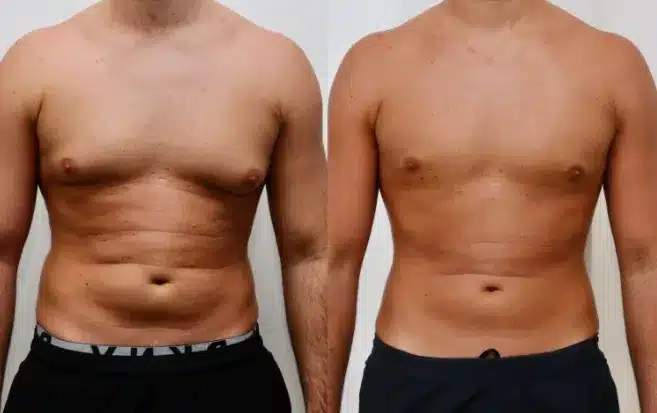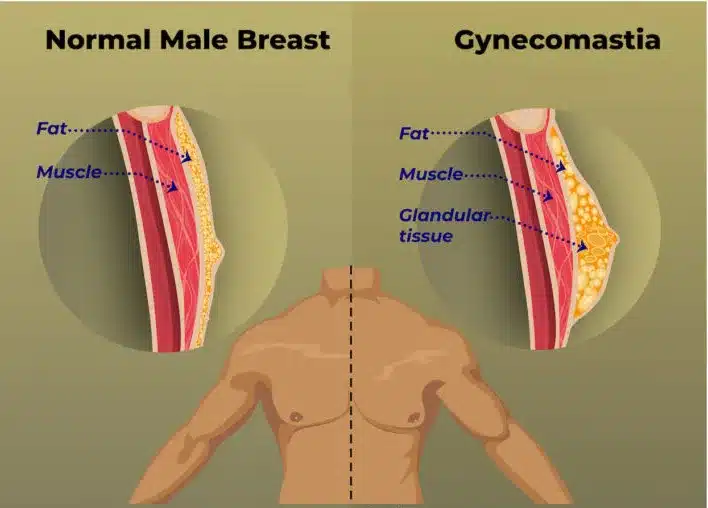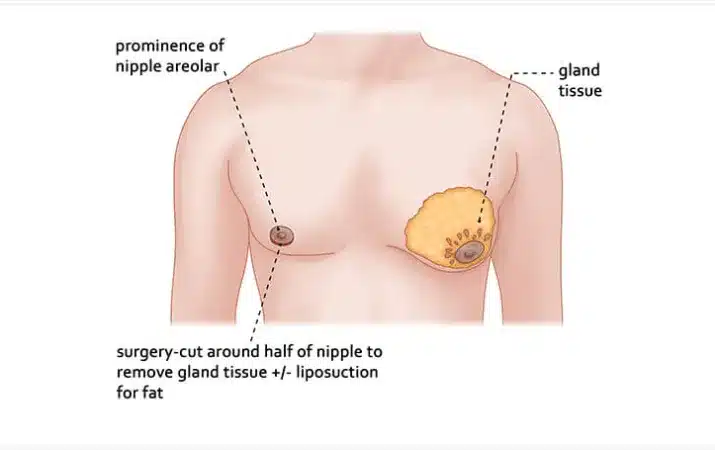Gynecomastia is a condition characterized by the enlargement of breast tissue in males. It can cause significant physical and psychological distress for those affected. Understanding male breast reduction surgery and its available solutions is essential for men seeking relief from this condition and its associated challenges.
Why Do Men Get Gynecomastia?
- Hormonal Imbalance: An imbalance in estrogen and testosterone levels can contribute to developing gynecomastia. This can occur during puberty, aging, or due to certain medical conditions or medications.
- Obesity: Excessive weight gain can lead to increased fat deposits, including in the breast area, resulting in gynecomastia.
- Genetics: Some individuals may have a genetic predisposition to developing gynecomastia, making them more susceptible to the condition.
- Lifestyle Factors: Substance abuse, including alcohol and drug use and certain medications, can contribute to gynecomastia development.
What Can Gynecomastia Surgery Do?
Male breast reduction surgery, also known as male breast reduction surgery, aims to address the enlargement of male breast tissue and restore a flatter and more masculine chest contour. The surgery can:
- Reduce Excess Breast Tissue: male breast reduction surgery removes excess glandular tissue and fat from the breasts, resulting in a flatter and more proportionate chest appearance.
- Enhance Body Confidence: Gynecomastia surgery can significantly improve a man’s confidence and self-esteem by achieving a more masculine chest contour.
- Improve Physical Comfort: Men with gynecomastia often experience physical discomfort due to the weight and size of their breasts. Surgery can alleviate this discomfort, allowing for greater freedom of movement and enhanced comfort.
- Restore Clothing Options: male breast reduction surgery expands clothing choices for men, allowing them to wear fitted shirts and clothing styles previously avoided due to self-consciousness.
Different Types of Gynecomastia
- True Glandular: This type of male breast reduction surgery results from the enlargement of glandular breast tissue and is often resistant to non-surgical treatments.
- Pseudo: Pseudogynecomastia is characterized by increased fatty tissue in the breast area, often caused by excess weight or obesity.
- Mixed: Mixed gynecomastia refers to a combination of glandular tissue enlargement and excess fatty tissue in the breasts.
- Unilateral: Unilateral gynecomastia affects only one breast, resulting in asymmetry in the chest area.
The specific type of male breast reduction surgery will be assessed during the consultation with a qualified plastic surgeon to determine the most appropriate treatment plan.
How Is Gynecomastia Surgery Performed? (Step by Step)
male breast reduction surgery typically involves the following steps:
- Anesthesia: The surgeon administers anesthesia to ensure the patient’s comfort and safety throughout the procedure. The choice of anesthesia can be discussed with the surgeon beforehand.
- Incision Placement: The surgeon carefully determines the incision placement based on the type and severity of gynecomastia. Incisions are typically made around the areola or in the natural creases of the chest to minimize visible scarring.
- Removal of Excess Tissue: The surgeon removes excess glandular tissue, fat, and, if necessary, repositions the nipples to achieve a more masculine chest contour.
- Suturing and Dressing: The incisions are meticulously closed with sutures, and dressings are applied to support the healing process.
- Recovery and Follow-Up: Patients are closely monitored in a recovery area after the surgery. They receive detailed instructions on post-operative care, including wearing compression garments, managing discomfort, and attending follow-up appointments.

10 Benefits of Gynecomastia Surgery
This surgery offers numerous benefits for men seeking a more masculine chest appearance. Some of the key benefits include:
- Improved Confidence: this surgery can significantly boost a man’s self-confidence and body image, allowing him to feel more comfortable in social and intimate settings.
- Enhanced Physical Comfort: Reduced breast size and weight can alleviate physical discomfort, allowing for increased mobility and improved posture.
- Restored Chest Contour: this surgery restores a flatter and more defined chest contour, enhancing the overall aesthetics of the upper body.
6 Risks of Gynecomastia Surgery
As with any surgical procedure, this surgery carries certain risks. It is essential to be aware of these potential risks, which may include:
- Bleeding
- Infection
- Scarring
- Changes in Sensation
- Asymmetry
- Unsatisfactory Results
Recovery Time from Gynecomastia Surgery
The recovery time from this surgery varies for each individual, but it typically follows a general timeline:
- Immediately Post-Surgery: Patients may experience some discomfort, swelling, and bruising. Pain medication and compression garments are often prescribed to manage these symptoms.
- First Week: The majority of swelling and bruising subsides during the first week. Patients should follow the surgeon’s instructions regarding rest, wound care, and wearing compression garments.
More than half of male newborns have enlarged breasts or breast buds. This condition is due to the mother’s estrogen levels. The enlarged breasts usually go away within a few weeks. Cleveland Clinic
What Age Can Get Gynecomastia Surgery?
This surgery is typically performed on individuals who have reached full physical development. This generally occurs after the age of 18. However, the eligibility for surgery is determined on a case-by-case basis, considering factors such as overall health, emotional maturity, and the severity of gynecomastia.

To-Do and Not-to-Do Things After Surgery
To ensure optimal healing and minimize complications, patients should follow these do’s and don’ts after this surgery:
Do’s:
- Follow Post-Operative Instructions: Adhere to the surgeon’s specific guidelines regarding medications, wound care, wearing compression garments, and activity restrictions.
- Attend Follow-Up Appointments: Regularly visit the surgeon for post-operative check-ups to monitor the healing progress and address any concerns.
Don’ts:
- Engage in Strenuous Activities: Avoid strenuous exercise, heavy lifting, and activities that put excessive strain on the chest area during the initial stages of recovery.
- Smoke or Use Nicotine Products: Smoking and nicotine use can impair healing and increase the risk of complications. It is essential to refrain from smoking before and after surgery.
summary
This surgery can significantly impact a man’s confidence and well-being. Male breast reduction surgery, or this surgery, offers a solution by reducing excess breast tissue and restoring a more masculine chest contour.
Did you know? That gynecomastia, often referred to as male breast reduction, is not always due to excess fat? Sometimes, it’s a result of hormonal imbalance, especially during puberty.
However, many people confuse it with pseudogynecomastia, which is actually due to fat accumulation and might benefit from procedures like liposuction.
Additionally, certain medications can unexpectedly induce gynecomastia as a side effect. So, the next time someone brings up the topic, you’ll have an exciting tidbit to share!”
FAQs
Q: What is gynecomastia? A: This surgery refers to the enlargement of breast tissue in males, leading to a more feminine chest appearance.
Q: Is gynecomastia surgery painful? A: This surgery is performed under anesthesia, so patients do not feel any pain during the procedure.



